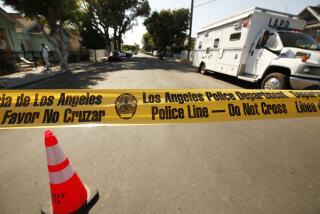City Has an ‘Archangel’ Overseeing Its Security
- Share via
When authorities warned last month of a possible terrorist plot against Eastern financial institutions, the Los Angeles Police Department dispatched special teams to high-profile Los Angeles-area banks to help guard against the possibility of a similar attack.
But efforts to protect those potential targets, and hundreds of others across the city, have gone well beyond merely reacting to the latest terror warnings, LAPD officials say.
Department counterterrorism officials have been working for the last 18 months to redefine the way the city secures its high-threat locations as part of a regional security cooperative they call “Archangel.”
“When I came here, I found there was no threat assessment system for our critical assets, and the information we did have was outdated, paper-based or got stale very quickly,” said John Miller, the LAPD’s counterterrorism chief. “There were just lists [of possible targets].”
Los Angeles features nearly every kind of security challenge imaginable, Miller said, from a dense urban core with gleaming high rises to suburban sprawl and bucolic mountain hideaways.
The city draws critical resources from a far-flung power grid and an intricate system of aqueducts, features a bustling port and airport, and has nationally recognizable landmarks such as Hollywood Boulevard, movie studios and entertainment venues.
Following the Sept. 11, 2001, Al Qaeda attacks on New York City and Washington, D.C., the LAPD identified more than 600 so-called critical sites across the city.
Other agencies had done similar reviews. State government had already ranked threats using a method devised in World War II to identify enemy bombing targets. And federal officials concentrated their attention on potential national security targets.
Yet those lists didn’t answer a fundamental question that would help local officials prepare for the inevitable terror attack, according to Lt. Tom McDonald, the LAPD’s point man for operation Archangel: “What exactly is a high-threat location?”
Coming up with a working definition required looking beyond traditional -- and narrow -- police perspectives.
Locally, the LAPD brought together a core group of agencies, which meets monthly to coordinate anti-terrorism plans.
They included the Los Angeles Fire Department, Department of Water and Power, Department of Recreation and Parks, the port and airport departments, the Los Angeles Unified School District, Department of Transportation and the Los Angeles County Sheriff’s Department and the Department of Health.
The LAPD also sought advice from the Terrorism Early Warning Group, Joint Terrorism Task Force including the Federal Bureau of Investigation, the U.S. Defense Department and Centers for Disease Control and Prevention as well as the U.S. and California departments of Homeland Security.
The consensus is that a high-threat location can be many things at different times of the day, week or month.
Highest priority is given to sites that deliver or produce life’s basic necessities, or are a fundamental part of the way society functions on a daily basis, whether it be transportation, communications, agriculture, or water and power, McDonald said.
But officials also want to protect locations that if attacked could cause mass casualties, including storage or production plants for nuclear energy, chemicals or military weaponry.
And like the World Trade Center buildings, there are symbolic or iconic sites that may be attractive targets to terrorists because they are considered emblematic of the American way of life, McDonald said.
Counterterrorism officials say that by trying to protect everything, authorities can fail to protect anything.
So in addition to ongoing threats, Archangel personnel must be mindful of transitory threats lasting hours, days or weeks.
The bottom line, Miller says, is that “intelligence drives the process” and threats “can ebb and flow.”
Still, preparation makes all the difference, he said. Archangel has developed action plans for businesses and government alike and the goal is to have the most updated information available to first responders so they can hit the ground running.
With the help of businesses and government, Archangel teams have assembled dossiers on hundreds of key buildings to help first responders. Information includes a rundown on every entrance or exit, location of elevators and air conditioning systems, possible landing areas for helicopters so that when police, firefighters or hazardous-materials crews roll up, they know exactly what they are facing and quickly can form an action plan.
Sites already targeted by terrorists include the Los Angeles International Airport and the U.S. Bank Tower, or Library Tower, which a captured Al Qaeda operative had said the group planned to hit in a second wave of attacks.
Archangel officials want to give enforcement and other participating agencies, including national entities such as the CDC, the ability to access the collected information immediately through a secure Internet site and provide guidance as events unfold. Local officials hope the security cooperative can ultimately be used as a national model for terror threat analysis.
Miller said Al Qaeda’s training includes surveillance to assess the layout of potential targets. Counterterrorism officials believe Al Qaeda armed assault teams could use that information to take over and hold a building.
“Our countermeasures have to be at least as good,” Miller said.
More to Read
Sign up for Essential California
The most important California stories and recommendations in your inbox every morning.
You may occasionally receive promotional content from the Los Angeles Times.










